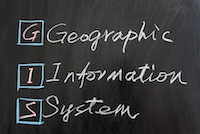GIS: The Power of Visualizing Hospital and Healthcare Data
 Editor Note: Geographic Information Systems—a data visualization and analysis tool—is finding useful applications in hospital and health system planning and marketing. Here's how GIS, along with predictive analytics and other data tools, is helping to shape near- and long-term marketing plans and strategies.
Editor Note: Geographic Information Systems—a data visualization and analysis tool—is finding useful applications in hospital and health system planning and marketing. Here's how GIS, along with predictive analytics and other data tools, is helping to shape near- and long-term marketing plans and strategies.
As we move into the future of healthcare marketing, a number of useful technologies are becoming available. Perhaps the most sophisticated of these new and sophisticated tools is Geographic Information Systems, or GIS for short.
GIS is a powerful mapping and decision-support tool that has been used widely by many differing types of organizations to reach goals ranging from determining where crime rates are highest in a city to predicting how temperature changes will affect our ecosystems.
In healthcare, hospital marketers are beginning to use GIS software to help form marketing strategies and plans. Gundersen Lutheran Medical Center in La Crosse, Wisconsin, is one example. The hospital has 25 clinics throughout Wisconsin, Minnesota, and Iowa and serves over 1 million people annually. Like most metropolitan areas, Gundersen Lutheran Medical Center is competing against other large healthcare organizations for patients.
To increase their competitive edge, Gundersen Lutheran is using GIS technology in their marketing strategy.Perhaps the biggest advantage to using a geographic information system is the ability to easily collect, organize and visually display demographic data. According to Jason Haley, a GIS manager for the advanced health care data company Stratasan, hospitals need to “be able to talk about their community, their patients, and their community’s health.”
In hospital marketing, using GIS successfully is a means to better understand the community and to anticipate needs in the service area. In a GIS system, this demographic data can be used to create different base layers that can be overlaid on one and another to find patterns that might not always be immediately apparent. Querying this data can answer many questions, and understand variables, about the marketing target audiences and anticipate successful approaches.
Once this data has been collected it becomes easier to answer questions such as: where are most of the patients coming from, how far do they travel to obtain the services that the hospital provides, what is the health of the community like, and if patients are not coming to my hospital then where are they most likely to go? Answering these questions with hard numbers makes it easier, for example, to determine where marketing dollars might be invested.
Gundersen Lutheran Medical Center has used their demographic data to determine where their competitors were garnering greater market shares. Furthermore, they were able to discern why this was happening—whether due to patient proximity to clinics or quality of service—in each case. With this data they can plan accordingly to improve their status in the market.
Gundersen Lutheran Medical Center has also used GIS to identify new service locations by comparing their data to potential clinic sites. This visual comparison aids in determining where a new clinic, and specifically which clinical service is likely to succeed. This allows for a “more simplified marketing strategy than by using individual Medical Practice Clusters, thus saving time and resources.”
The State of California has also used GIS to help hospitals determine market share. Their interactive map uses demographic data such as zip codes and inpatient data to determine the size of each hospital’s core market.
They have also analyzed the demographic data collected in their system to determine the types of patients that typically come to each hospital. Doing this helps inform marketing by helping hospitals and clinics advertise to the types of patients that live in the area.
The system can be used to determine the routes the target audience is likely to travel by and suggest locations for billboards or additional advertisements. GIS can help identify and cultivate a hospital’s most profitable services.
Thus far, geographic information systems in the hospital marketplace are primarily used in identifying the types of services needed and in searching for markets that can be exploited. The tool has been shown to streamline marketing and increase efficiency in health care services. As we move into the future, GIS within the hospital marketplace will become more popular and likely become commonplace.
# # #








